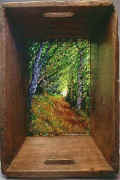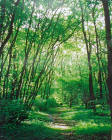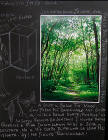|
Dimensional Fused Glass Technique:
Painting WITH Glass Frits&Wire
The
Dimensional Fused
Glass Technique is derived from the
process of Light
Painting Technique, developed by Narciso Quagliata in 1993. He used frits (finely
ground glass) & glass wire for Abstract Work, Human Figures and Nature Themes.
After learning from Mr. Quagliata, I decided to apply the same method for
Landscapes using glass as if it was watercolors. After numerous experiments,
I found out that the basic technique was not enough to achieve the result I
wanted. I began then working on sequential kiln fusing.
I adhere to the sequence below, part of which is
illustrated in my Cofanetto piece above:
I choose the setting, always a real place to which I am
emotionally attached. I take photographs of the site in different seasons, under
a variety of lights and views and with different frames of mind.
I use Bullseye Glass Frits, from an American Co. based in Oregon. The
Bullseye glass has a wide range of colors compatible with each other. I use the
frits to create the smudge part of a landscape. For the linear portion of (tree
trunks and branches) I make my own glass wires by melting in a little
pot the frits and shape with a soft flame.
I start on a glass sheet to create the background of the landscape, using
frits and wires. When I
finish with the
first layer, I place the glass sheet in the furnace at a temperature
of 810°C.
I repeat the procedure over and over till the piece acquires the right c olor
intensity. olor
intensity.
For instance, a two millimeter
green color spot does not show its real color until
it reaches an
optimal thickness.
I then heat the piece in the furnace several times in order
to give it optical depth.
This means that I add colorless glass of different
thickness by starting from in the area
that must have the furthest perspective, and gradually use bigger glass sheets
to get to
the depth I want to achieve. In my most recent work I usually melt a
thick (6mm) sheet of
glass over the entire surface of the piece.
Each of my pieces is
heated in the furnace at least seven times. If the images
have a lot of
details, 10 or more fusions are needed. With each heating, the process
becomes
more delicate. With the increasing glass thickness, the risk for breakage
increases. In addition to the difficulty in reheating, the cooling
off must be strictly controlled to avoid permanent tensions in the glass.
The whole process requires a minimum of 4 weeks per piece.
Revised July 2003
|






